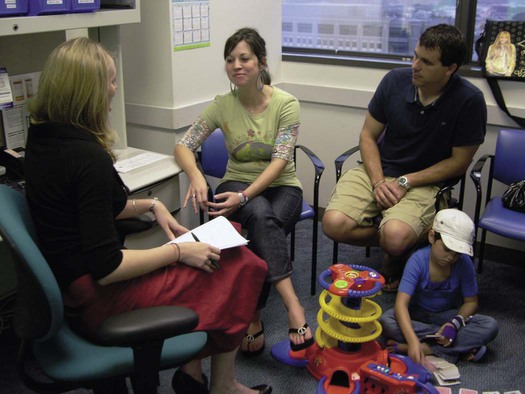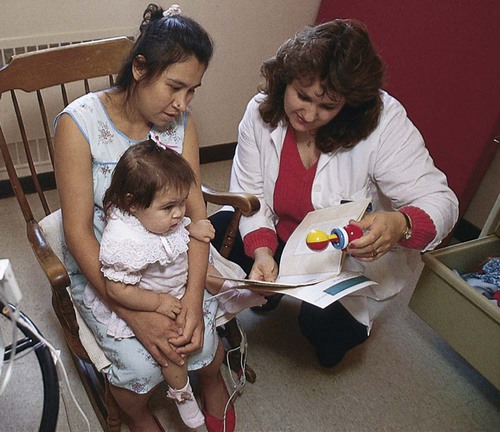On completion of this chapter the reader will be able to: • Identify communication strategies for interviewing parents. • Formulate guidelines for using an interpreter. • Identify communication strategies for communicating with children of different age groups. • Describe four communication techniques that are useful with children. • State the components of a complete health history. • List three areas that are evaluated as part of nutritional assessment. • Prepare a child for a physical examination based on his or her developmental needs. • Perform a comprehensive physical examination in a sequence appropriate to the child’s age. • Recognize expected normal findings for children at various ages. • Record the physical examination according to the head-to-toe format. http://evolve.elsevier.com/wong/essentials Animations—Abdominal Anatomy; Cranial Nerves; Organ Systems 3-D Tour Case Studies—Communicating with Adolescents; Pediatric Assessment Introduce yourself and ask the name of each family member who is present. Address parents or other adults by their appropriate titles, such as “Mr.” and “Mrs.,” unless they specify a preferred name. Record the preferred name on the medical record. Using formal address or their preferred names, rather than using first names or “mother” or “father,” conveys respect and regard for the parents or other caregivers (Seidel, Ball, Dains, and others, 2011). The place where the nurse conducts the interview is almost as important as the interview itself. The physical environment should allow for as much privacy as possible with distractions, such as interruptions, noise, or other visible activity, kept to a minimum. At times, it is necessary to turn off a television, radio, or cellular telephone. The environment should also have some play provision for young children to keep them occupied during the parent–nurse interview (Fig. 6-1). Parents who are constantly interrupted by their children are unable to concentrate fully and tend to give brief answers to finish the interview as quickly as possible. Many institutions use computer and information applications in nursing (nursing informatics), such as electronic medical records, to record care and access information. Two important health care applications are record transmission, including facsimile (fax), electronic mail (e-mail), and telemedicine. The telemedicine application is capable of two-way video conferencing, transmission of radiographs, and clinical consultation between remote sites and centralized resources.* Nurses are increasingly responsible for assessing children’s symptoms and applying clinical judgment for further medical care (triage) via telephone report. Most often, health problems are assessed and prioritized according to urgency, and nurses provide treatment via telephone services. A well-designed telephone triage program is essential for safe, prompt, and consistent-quality health care (Beaulieu and Humphreys, 2008; Marklund, Ström, Månsson, and others, 2007). Telephone triage is more than “just a phone call” because a child’s life is a high price to pay for poorly managed or incompetent telephone assessment skills. Typically, guidelines for telephone triage include asking screening questions; determining when to immediately refer to emergency medical services (dial 911); and determining when to refer to same-day appointments, appointments in 24 to 72 hours, appointments in 4 days or more, or home care (Box 6-1). Successful outcomes are based on the consistency and accuracy of the information provided. Telephone triage care management has increased access to high-quality health care services and empowered parents to participate in their children’s medical care. Consequently, patient satisfaction has significantly improved. Unnecessary emergency department and clinic visits have decreased, saving medical costs and time (with less absence from work) for families in need of health care. Silence as a response is often one of the most difficult interviewing techniques to learn. The interviewer requires a sense of confidence and comfort to allow the interviewee space in which to think without interruptions. Silence permits the interviewee to sort out thoughts and feelings and search for responses to questions. Silence can also be a cue for the interviewer to go more slowly, reexamine the approach, and not push too hard (Seidel, Ball, Dains, and others, 2011). Empathy is the capacity to understand what another person is experiencing from within that person’s frame of reference; it is often described as the ability to put oneself in another’s shoes. The essence of empathic interaction is accurate understanding of another’s feelings (Mathiasen, 2006). Empathy differs from sympathy, which is having feelings or emotions similar to those of another person, rather than understanding those feelings (Mathiasen, 2006). Unprepared parents can be disturbed by many normal developmental changes, such as a toddler’s diminished appetite, negativism, altered sleeping patterns, and anxiety toward strangers. The chapters on health promotion provide nurses with information for counseling parents. However, anticipatory guidance should extend beyond giving general information during brief visits to empowering families to use the information as a means of building competence in their parenting abilities (Magar, Dabova-Missova, and Gjerdingen, 2006). To achieve this level of anticipatory guidance, the nurse should: A number of blocks to communication can adversely affect the quality of the helping relationship. The interviewer introduces many of these blocks, such as giving unrestricted advice or forming prejudged conclusions. Another type of block occurs primarily with the interviewees and concerns information overload. When individuals receive too much information or information that is overwhelming, they often demonstrate signs of increasing anxiety or decreasing attention. Such signals should alert the interviewer to give less information or to clarify what has been said. Box 6-2 lists some of the more common blocks to communication, including signs of information overload. Active attempts to make friends with children before they have had an opportunity to evaluate an unfamiliar person tend to increase their anxiety. Continue to talk to the child and parent but go about activities that do not involve the child directly, thus allowing the child to observe from a safe position. If the child has a special toy or doll, “talk” to the doll first. Ask simple questions, such as “Does your teddy bear have a name?” to ease the child into conversation. Other guidelines for communicating with children are in the Nursing Care Guidelines box. Specific guidelines for preparing children for procedures, a common nursing function, are provided in Chapter 22. The normal development of language and thought offers a frame of reference for communicating with children. Thought processes progress from sensorimotor to perceptual to concrete and finally to abstract, formal operations. An understanding of the typical characteristics of these stages provides the nurse with a framework to facilitate social communication (Box 6-3). Everything is direct and concrete to small children. They are unable to work with abstractions and interpret words literally. Analogies escape them because they are unable to separate fact from fantasy. For example, they attach literal meaning to such common phrases as “two-faced,” “sticky fingers,” and “coughing your head off.” Children who are told they will get “a little stick in the arm” may not be able to envision an injection (Fig. 6-3). Therefore, avoid using a phrase that might be misinterpreted by a small child (see Table 22-1). Nurses use a variety of verbal techniques to encourage communication. Some of these techniques are useful to pose questions or explore concerns in a less threatening manner. Others can be presented as word games, which are often well received by children. However, for many children and adults, talking about feelings is difficult, and verbal communication may be more stressful than supportive. In such instances, use several nonverbal techniques to encourage communication. Box 6-4 describes both verbal and nonverbal techniques.
Communication and Physical Assessment of the Child
Guidelines for Communication and Interviewing
Establishing a Setting for Communication
Appropriate Introduction
Assurance of Privacy and Confidentiality
Computer Privacy and Applications in Nursing
Telephone Triage and Counseling
Communicating with Families
Communicating with Parents
Using Silence
Being Empathic
Providing Anticipatory Guidance
Avoiding Blocks to Communication
Communicating with Children
Communication Related to Development of Thought Processes
Early Childhood
Communication Techniques

Communication and Physical Assessment of the Child
Get Clinical Tree app for offline access





